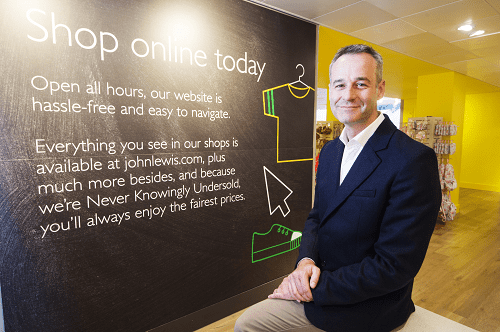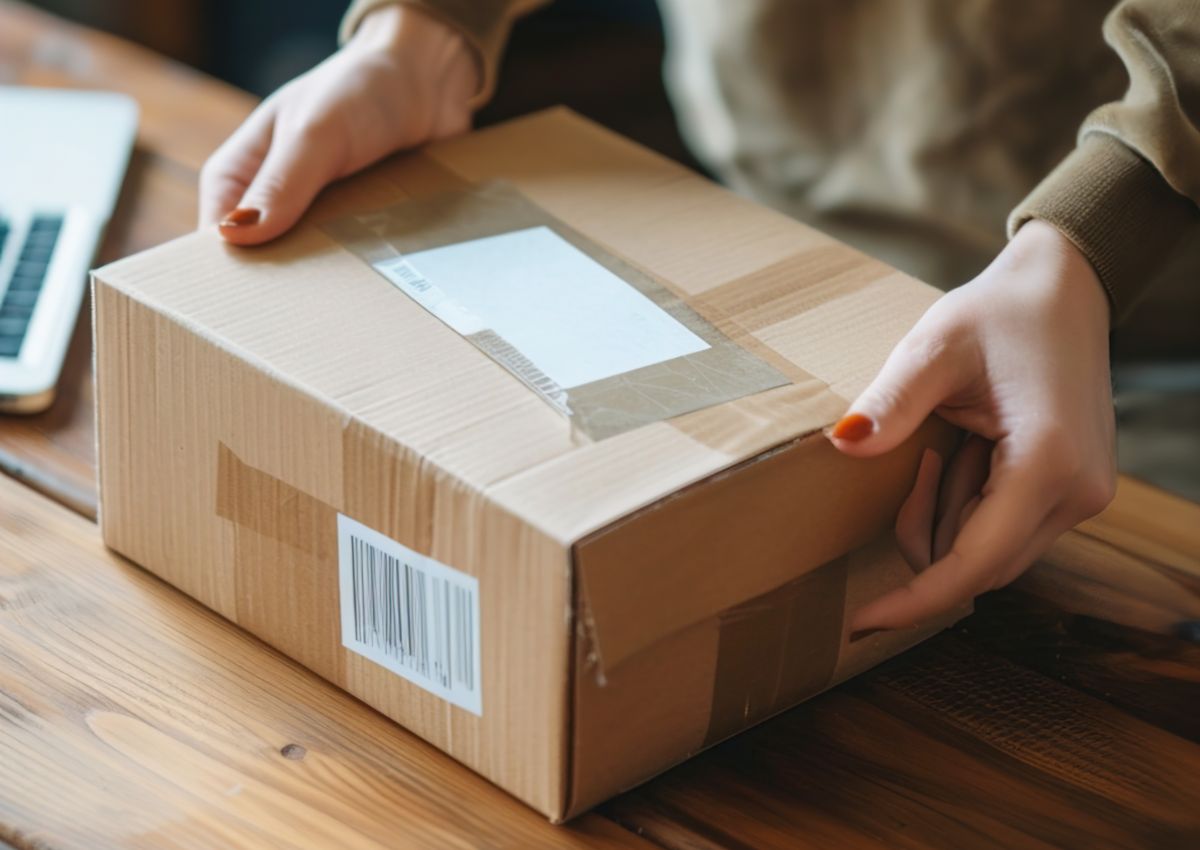InternetRetailing caught up with Mark Lewis, Online Director of John Lewis , following his keynote presentation at the InternetRetailing Conference, to ask him more about transformation and why innovation and investment are key to omnichannel success.
John Lewis tops many shopper surveys for its customer experience and trustworthiness. It has also picked up accolades for various elements of its omnichannel development and was crowned Best Multichannel Retailer at the 2014 Retail Week Awards.
But Mark Lewis, John Lewis’ Online Director, believes that the company is only at the very beginning of its omnichannel journey. “We’ve cleared the first hurdle,” he says.
That first hurdle is proving a success for the retailer, since a third of its sales now come from its online channel, accounting for £1.1bn in the past financial year. Store sales were up 3.6% in the first half of this, its 150th anniversary, year with online growth reaching 25.6%.
“Now a number of us have built quite sizeable online businesses in the UK there’s a temptation to think we’re close to the end of this race,” he told delegates at the InternetRetailing Conference. “But I think, if anything, we’re at the very beginning of it. This journey is ahead of us rather than behind us. These next three to five years will see more changes to retail than in our generation.”
THE JOURNEY
John Lewis, like any retailer, is well used to change. Established a century and a half ago by John Spedan Lewis as an experiment in industrial democracy, it has remained focused on its founding principles, set out in the John Lewis Partnership Constitution, such as a common set of incentives.
“The core values of the John Lewis Partnership have remained and that’s what has helped us through the changes,” says Lewis. “They’ve allowed us to invest for the long term” and that has helped with omnichannel investments and allowed the retailer to scale innovations. “This has been one of the key reasons for our success,” says Lewis.
“Supply chain is the unsung hero of ecommerce,” says Lewis. In fact, he thinks it’s absolutely critical and it’s an area in which John Lewis has been able to make big innovations. “We’ve been able to take a business that not that long ago was only able to deliver product in bulk into a small number of locations for store replenishment, into a business that does that very well and also delivers product individually picked, individually wrapped, packed and sent to the individual customer in their home or to a collection point.”
“That’s a reengineering of the supply chain,” he says, especially when it’s done in a way that delivers a customer experience that is compatible with what the brand promises. “It’s important that we get that right and the investments necessary to get that right at scale.”
These next three to five years will see more changes to retail than in our generation
For example, with click and collect, the retailer started by enabling it in John Lewis stores and then extended it to its Waitrose outlets. Its latest extension of the concept is its new ‘Click and Commute’ store at St Pancras International station, which opened on the day of the conference, enabling commuters to pick up online orders and drop off returns. More than half of all John Lewis items bought online are now fulfilled through click and collect.
The St Pancras small format Click and Commute shop stocks a limited range of John Lewis items from its electronics, gifts, beauty, home and fashion ranges, and also operates as a collection and returns point for johnlewis.com orders. The shop, which according to forecasts will see 48 million people pass its doors every year, opened on 14 October. It’s unlikely that this will remain the only one of its kind since Lewis says the firm plans further innovation in delivery “as customers are telling us that convenience is really important to them and we see that they respond really well when we offer increased convenience”.
This year alone, John Lewis has extended its click and collect network, added a further 90 Waitrose stores where orders can be collected, rolled out Collect+ nationwide and launched Click and Commute. “So you can see that the direction of travel is all about offering increased convenience,” says Lewis.
The retailer has invested heavily across the board and he sees this commitment continuing. IT spend, for example, has increased from 15% CapEx over the 2009-2013 period to 37% for 2014-2018.
To date, its investments have included buying the assets of buy.com in 2001, investing in the 650,000 square foot Magna Park distribution centre in 2008 and putting £97m into a second building to double capacity. “We’ve invested very heavily in infrastructure such as supply chain to allow us to offer great customer service online as well as in stores, a central distribution centre, click and collect, all to really deliver that proposition,” he explains. These investments involve tens of millions of pounds, Lewis adds.
At the same time, John Lewis has invested very heavily in much smaller-scale advances in a bid to “deliver continuous improvement to the customer experience” along with innovations which may be scaled up.
He believes that retailers need to invest across the board, putting money into everything from very significant big ticket items such as the supply chain to smaller, incremental improvements, such as enhancing its website user experience. “We’ve probably made a hundred changes to the customer experience this year alone to try and enhance the experience for the customer,” he comments.
It is this style of investment that he believes is really beginning to change how firms approach their business models. The next phase of omnichannel growth is not about setting up a nice website or opening a new shop, he says: “It’s about reengineering the whole business.”
Everything across the John Lewis business has been realigned for omnichannel, he explains, and it is trying to embed the continuous improvement culture of fail fast into the broader retail business.
“Above all else we invest in one thing: trust,” he says. This, he adds, is at the heart of John Lewis’ relationship with its customers. To illustrate this point at the conference, he showed delegates the retailer’s 2010 ‘always a women’ advert, in which John Lewis highlighted its lifelong commitment to its customers. He said “We found our voice here and shared it with customers in a very compelling way.”
INNOVATION
The company keeps an open mind on sources of innovation, and this is led by customers and by technology. When asked what early stage innovation looks like, he showed delegates an example of an app that’s being trialled in its Oxford Street store to enable customers to visualise different shapes of sofas in a range of colours. (John Lewis’ Any Shape, Any Fabric collection generates nearly 70% of all made-to-order sales in upholstery.) The app, which was developed by an in-house software engineer, uses 3D printed sofas which are small enough to fit into a customer’s hand. Each has an embedded RFID tag. A range of fabric swatches has also been tagged so the system can identify the sofa shape being held, display it on a screen and then cover the sofa with the different fabric swatches as the customer picks them up. Fifteen different sofa shapes and 20 fabrics are currently being merchandised in this way. “Maybe customers will love it, maybe they won’t,” says Lewis.
John Lewis has a raft of plans involving all sorts of new technologies. These include experimenting with groundbreaking technology. “The question is working out which ones are really getting traction with the customers, which we can get behind and really scale as quickly as possible.”
Lewis says: “Internally, you have to create dialogue around risk with the team and to gauge projects on their merits; whether they are high risk so you need to spend time thinking about them, or they are low risk and can be pulled back in 10 minutes.”
JLAB
John Lewis has already broken new ground this year with the launch of its first technology business incubator, JLAB. Five start-up companies – Localz, Musaic, SpaceDesigned, Tap2Connect and Viewsy – were mentored for 12 weeks by partners from John Lewis and external entrepreneurs including the Chairman of Risk Capital Partners, Luke Johnson, founder of confused.com Sara Murray OBE, and the Vice President of Entrepreneur Banking at Silicon Valley Bank, Bindi Karia.
After developing their solutions with the help of JLAB, the companies delivered their final pitch on 23 September. Localz, a startup business specialising in micro-location technology, impressed the judging panel to become the overall winner and take home the £100,000 in investment capital as well as the chance to trial its solution with John Lewis.
Its technology enables customers to take advantage of enhanced services using their smartphone based on their precise location. For example, it could automatically offer to trigger a customer’s click and collect order to be picked as they enter the shop to speed up the collection, or help customers to navigate their way around one of the shops based on their online wish list.
“We’re now working with the company so we can bring their beacon technology into the customer experience,” says Lewis. The retailer is also working with some of the other companies that took part in JLAB.
FUTURE VISION
As to the future, that’s something that’s constantly changing and nobody truly knows what’s next for retail, explains Lewis. If you look back over recent years, the iPhone has been around for 7 years and the iPad for 4, and together they now account for over half of John Lewis’ business.
Customer behaviour, data and delivery will drive change
You have to have a clear view and be able to correct the course you’re taking with technology, he advises. There are clues, though, to future trends in the way that customers are shopping: they are combining shopping journeys across channels and researching online before going to stores. Some 64% of John Lewis customers shop across channels, 20% shop in store only and 16% online only. According to Lewis, the role of the store is still very significant in terms of browsing and fulfilment.
Looking ahead, he says that customer behaviour, data and delivery will drive change in the business. These are his key predictions:
1) Changing customer behaviour. Lewis thinks there will be more convergence of digital and store retailing such as downloading magazines to tablets, customers using their own devices in store and mannequins which allow customers to order the items the dummies are wearing (an innovation that’s already being showcased in its new York shop).
Traffic to johnlewis.com from mobile devices overtook desktop in December 2013 and now accounts for 53% of all web traffic. The rise of mobile shopping has seen more people making purchases in the early hours, with online sales between midnight and 6am up 31% over the past year, according to the company’s ‘How we shop, live and look’ study.
What people buy at night makes for fascinating reading. At 2am, men log on to buy formal wear, perhaps indulging in post-party purchasing. At around 4am, the nation’s parents seek to make the most of waking early by shopping for nursery items for their little angels. Between 5am and 7am sales of women’s shoes and handbags get a boost as Britain’s females log on to add to their wardrobes.
While mobile has become increasingly important, the ability to mix and match purchase channels and delivery options is now the norm.
2) Personalisation and data. Retailers will increasingly see that dynamic changing physical experiences as well as digital.
3) Delivery. From the excitement of ordering to receiving an item, there’s more to come from retailers and carriers in the area of what happens once the customer has pressed the ‘buy’ button.
“The big bet that we are actually making on behalf of our customers is that they like to shop across all of the channels and we see lots of evidence to suggest they are increasingly blurring their shopping journeys across stores and online. So it simply isn’t the case that customers shop one channel or the other,” Lewis says. “Particularly for us, with the types of products that we sell, we see that they like to combine the different channels as part of their journey.”
“This increasing blending and combination of stores and online is really our big directional change. The question as part of that vision and direction of travel is what steps should you take.”
The retailer’s future direction is very clear: it’s is aiming to be a leading omnichannel retailer. “However”, says Lewis, “the biggest challenge we face is actually deciding, out of all of the opportunities that are available to us, which are the ones to get behind.
“We think, in the whole scheme of things, that this is quite an early stage in our journey to omnichannel. We’re very proud of the progress we’ve made, but we’d be the first to say this is the very beginning. There are a few runners and riders who are doing good and exciting things, but I believe the pace of change is going to accelerate, so the requirement to begin to re-engineer our business models is going to become even more important. It’s an exciting time.”
Mentioned in this article
John Lewis: johnlewis.com
JLAB: jlab.co.uk
Localz: localz.co
Musaic: musaic.com
SpaceDesigned: spacedesigned.com
Tap2Connect: tap2connect.com
Viewsy: viewsy.com
Internet Retailing Conference 2014: internetretailingconference.com
John Lewis on IRDX: internetretailing.net/organisations/rjlw





